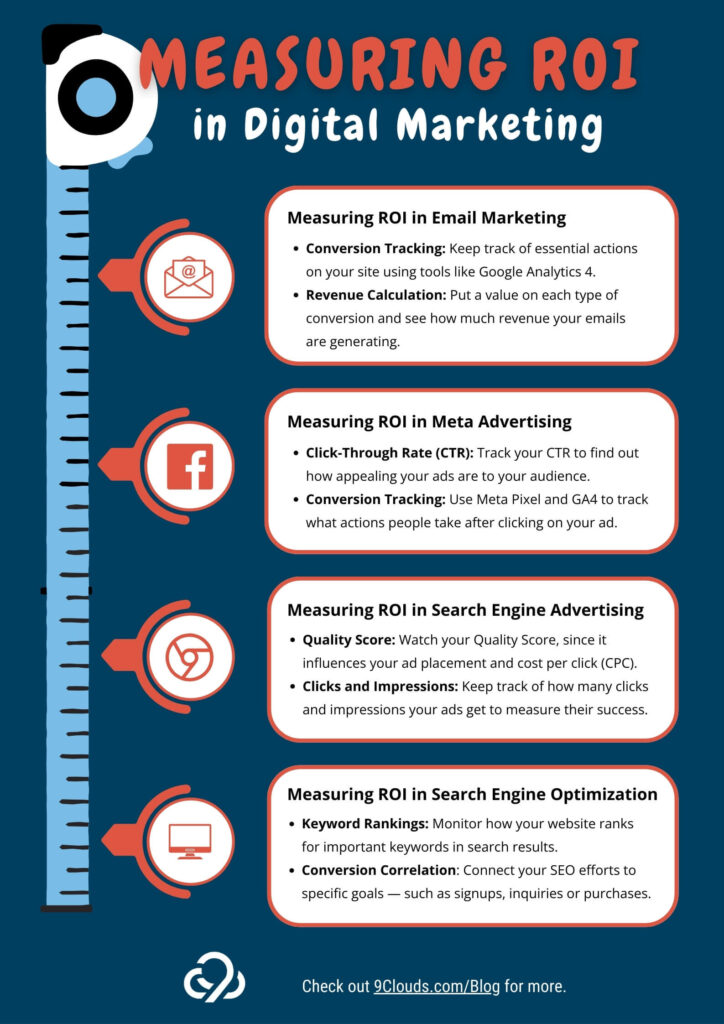
Our Best Tips for Measuring ROI in Digital Marketing
Whether they work in livestock, healthcare, automotive or anywhere in between, digital marketing professionals continually seek ways to measure the return on investment (ROI) for their strategies.
It can be a challenge to measure ROI across critical digital marketing tactics. Here’s how you can assess some of those specific tactics to elevate your marketing game.
If you like infographics instead, there’s one at the bottom of this post!
Before You Start: Define Success
In order to measure the ROI for any online advertising, you’re going to need to know what success really means for your business.
What is your business goal? What do you want your emails, digital ads or SEO to do for you?
The answer is commonly some portion of the marketing or sales funnel — like reach, impressions, subscriptions, leads and sales. Identify what’s important to you in a specific tactics, and use that as a framework for understanding your return on investment.
Speaking of specifics, here’s how we recommend you figure out ROI for different platforms and tactics.
Section 1: Measuring ROI in Email Marketing
Email marketing remains a stalwart tool for engaging target audiences.
To gauge ROI in this, the oldest of digital media, consider these steps:
- Conversion Tracking: Use precise conversion tracking tools such as Google Analytics 4 and LeadsRx to monitor vital actions such as clicks, sign-ups and purchases stemming from email campaigns.
- Revenue Calculation: Attribute values to various conversion types and calculate the overall revenue generated through email campaigns.
- Cost Breakdown: Look at the total costs of email campaigns, including design, content creation and email software expenses.
- Using Attribution Software: Consider using third-party software (e.g., LeadsRx) to accurately attribute conversions and determine the full impact of your email marketing efforts.
Section 2: Measuring ROI in Meta (Facebook) Advertising
Social media platforms like Facebook and Instagram offer advanced targeting options for their advertising.
Here’s what we look for in measuring ROI for Meta advertising:
- Click-Through Rate (CTR): Monitor the CTR to assess the engagement level of your ads with the target audience.
- Conversion Tracking: Implement Meta Pixel tracking to measure the actions taken after clicking on your ad, such as website visits, signups or purchases.
- Attribution Models: Select the right attribution model (e.g., first-click, last-click, multi-touch) to accurately assign conversions to relevant touchpoints.
- Third-Party Attribution: Employ third-party attribution software (e.g., LeadsRx) to analyze the full customer journey, from the first interaction to conversion or sale.
Section 3: Measuring ROI in Google Ads
Many businesses use Google Ads to show up at the top of competitive search engine results pages (SERPs).
Here are data points you should look at to measure the ROI of Google Ads effectively:
- Quality Score: Regularly monitor the Quality Score of your ads, as it impacts your ad placement and cost per click (CPC).
- Clicks and Impressions: Track the volume of clicks and impressions to gauge your ad performance. (Lots of impressions but few clicks? Either you’re not showing to the right people or your ads aren’t getting people to click.)
- Conversion Tracking: Set up precise conversion tracking to measure actions like form submissions, purchases or downloads resulting from ads.
- Cost Per Conversion: Calculate the cost per conversion by dividing the total Google Ad costs by the number of conversions.
Section 4: Measuring ROI in SEO
Search Engine Optimization (SEO) centers on your visibility in organic search.
Though direct ROI measurement can be challenging, here’s how to assess its effectiveness:
- Keyword Rankings: Monitor your website’s rankings for target keywords to gauge its prominence in search results.
- Organic Traffic: Track the quantity of organic traffic your website attracts over time.
- Conversion Correlation: Connect your SEO efforts to specific goals — such as signups, inquiries or purchases — to indirectly measure ROI.
- Third-Party Attribution: Use third-party attribution software (e.g., LeadsRx) to connect your SEO efforts with the complete customer journey, giving you a more accurate assessment of ROI and return on ad spend.
Is Your Marketing Successful?
Being able to measure ROI effectively across different digital marketing strategies and tactics gives professionals in any field the power to make smarter decisions.
With conversion tracking, analyzing data and expenses, and employing third-party attribution software, you can make sure you’re spending your budget where it really counts.
Ready to take the next step toward real marketing success? Start with one of our Marketing ROI packages. They help you really understand your ROAS and see where you should invest more in your marketing (and where you should spend less).
I WANT TO IMPROVE MY ROI »






